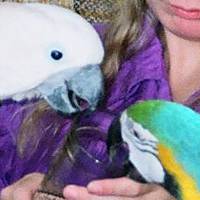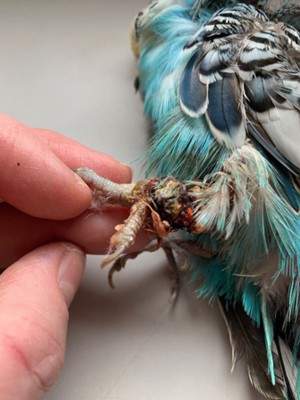
As a caregiver to parrots for many years, I learned about dangers and hazardous practices that could affect the health of my beloved companions. Here is a summary of my research on leg bands.
Leg Bands: Why Do People Use Them?
Breeders place leg bands on young chicks to identify them. A typical band will allow a breeder to distinguish individual birds in the flock and ensure the prevention of inbreeding.
Owners sometimes put bands on mature birds after DNA gender identification. A band on the right leg indicates that a bird is male, and on the left leg shows that it is female.
Some owners have bands made with identifying information such as phone numbers.
Closed leg bands are placed on chicks. Each chick’s foot is nudged through the hole in the band, and as the bird matures, the only way the band can be removed is to cut it off.
Mature birds are fitted with open bands that are squeezed closed after fitting.
Disadvantages of Banding
- They can act as tourniquets on tender legs, cutting off circulation and leading to injuries, deformities, or necrosis.
- They may provide havens for mites in some species.
- Larger birds such as macaws may bend or otherwise damage them, transforming them into misshapen objects that bite into legs. This creates the potential for infections that could lead to necrosis. As any experienced pet-bird lover can attest, if there’s a way for birds to get into trouble, they’ll find it.
- Skin may grow over too-tight bands, requiring surgical removal and repair.
- Leg bands may catch on toys, strings, cage accessories, and other objects.
- If a cage has bars that narrow, a band may become lodged in the narrowed spaces. In an attempt to free the leg, a bird may injure the limb or gnaw off a foot. Fractures, sprains, dislocations, and other injuries may also ensue.
- Seeds, food, dirt, and other substances may lodge between bands and legs.
- Some bands will separate, causing sharp metal to dig into a bird’s tender skin. Since this is invisible to caregivers, a bird may become terminally ill before the injury is noticed.
- In some cases, veterinarians have had to amputate feet and limbs to save a bird’s life.

Please Read This from an Avian Veterinarian
Why avian vets HATE leg rings!!! We see injuries like this regularly.
Leg rings catch on things, leg rings can cause callusing, leg rings can tighten and cut off circulation, leg rings can cause discomfort and trigger plucking, leg rings can be the wrong size, leg rings can cause a bird to lose its leg. Leg rings do not help a lost bird get home. They do not identify a bird to anyone other than the breeder that put it there. LEG RINGS KILL.
If your bird has a leg ring, we encourage you to get it removed by an avian vet (don’t do it yourself — you should see those injuries). If you want your bird to be easily identified, get your bird microchipped. Yes that’s a thing. Birds can be microchipped and we’d much rather that, than to see one more bird suffer like the budgie in our picture. Please share. Awareness really needs to be raised.
Link goes to a Bird Vet Melbourne Facebook post. Photo and text used with permission.
Bottom Line
If you care about your companion bird’s health, please take him or her to an avian veterinarian and have the leg band removed. Mini microchips are a far safer option.
The Writer’s Lexicon series
and additional resources on my Facebook page.
Discover more from KathySteinemann.com: Free Resources for Writers
Subscribe to get the latest posts sent to your email.

To whom this may concern:
Both of my African Greys have metal band on their legs. Are there any foot ring designed out there for attaching to this foot ring?
Have you considered removing the leg bands and having the birds microchipped instead?
I have a pair of young fantail Doves. About four weeks ago the male bird developed a limp. Contacted the vet who suggested it could be a strain, however, he suggested that if the limp remained or worsened then to bring the bird in for examination. The limp worsened and the bird was taken was taken into the vet for examination. The examination revealed that the plastic ring on his leg had broken the skin and penetrated the flesh resulting in a very nasty open wound, revealing the bone.
The vet removed the ring, injected the bird against infection and the bird was put on antibiotics and pain killers for five days.
Warning~ If leg rings are used, frequent examinations of the bird is necessary.
Thanks for sharing your experience, Dennis. I hope other friends of companion birds read your words and heed them.
Why not just get a paper band like the ones at carnivals or hospital why a metal band
Paper would be chewed away within seconds.
I don’t have a parrot, but I do love them. They’re beautiful and cute. I sometimes spend a few minutes looking at parrots in a nearby bird shop 🙂
I’m on a personal crusade to provide loving homes for parrots from bird sanctuaries rather than buy them from pet stores. Thousands, perhaps even millions, of birds worldwide exist in sub-standard conditions. Many species live for eighty years or more. What a long time to exist in filth, pain, loneliness, or hunger.